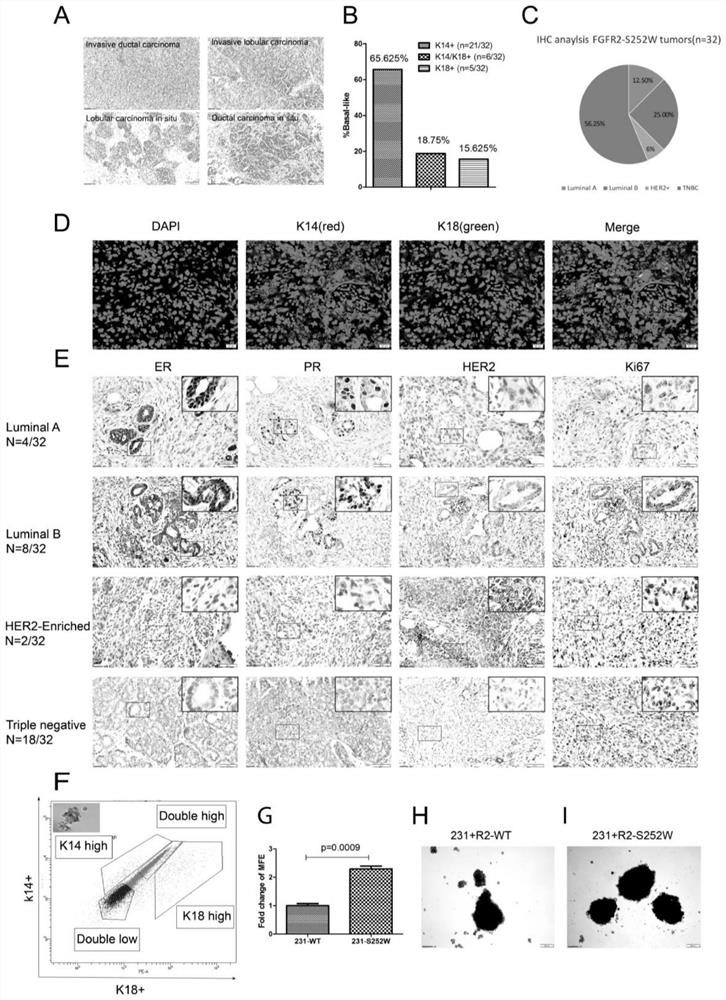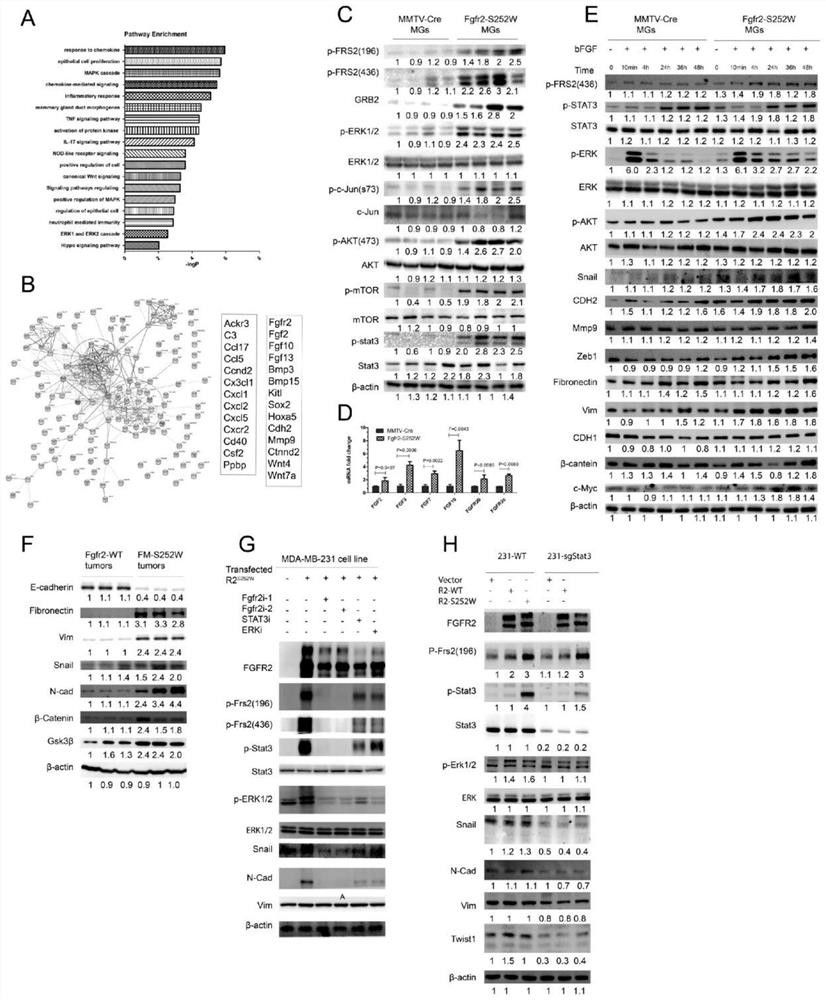Application of FGFR and related signal pathway inhibitor thereof in preparation of medicine for treating FGFR2 mutant tumors
A technology of FGFR2 and signaling pathway, applied in the field of biomedicine, can solve the problem of unclear mechanism of action of breast cancer
- Summary
- Abstract
- Description
- Claims
- Application Information
AI Technical Summary
Problems solved by technology
Method used
Image
Examples
Embodiment 1
[0045] Example 1: Fgfr2 mutation enhances mammary gland branching morphogenesis and promotes mammary gland tumor formation.
[0046] Application of loxp system to specifically activate Fgfr2 in mammary gland tissue, panorama of Fgfr2-S252W mouse mammary gland compared with wild-type (WT) mice, Fgfr2-S252W mouse mammary gland branching is denser ( figure 1 Middle A-C). Tissue sections showed that the number of cells in the mutant mice was relatively more ( figure 1 Middle D). CD29 in mammary epithelial cells revealed by flow cytometry Hi CD24 Med group relative increase ( figure 1 Middle E–F), These characterizations of mammary stem cells suggest that activation of Fgfr2 enhances mammary branching morphology and epithelial cell proliferation, thereby increasing the number of mammary stem cells and promoting tumor formation. Nine months later, mammary tumor development in Fgfr2-S252W mice was observed. During the 22-month period of continuous observation, mammary tumors we...
Embodiment 2
[0047] Example 2: Fgfr2 activation promotes the development of triple negative breast tumors.
[0048] Mammary tumors associated with Fgfr2 mutations were characterized by pathological analysis of mammary tumor tissues from Fgfr2-S252W mice. It was mainly invasive ductal carcinoma (IDC), accounting for 75% (24 / 32), and the rest were invasive lobular carcinoma, lobular carcinoma in situ and ductal carcinoma in situ ( figure 2 Middle A). Immunofluorescence (IF) showed that 65.625% (21 / 32) of breast tumors were basaloid carcinoma, and 34.375% (11 / 32) of other tumors were tubular tumors ( figure 2 Middle B, figure 2 Middle D).
[0049] Molecular subtypes of breast cancer showed that 4 / 32 (12.5%) were Luminal A type (positive estrogen receptor and / or progesterone receptor, HER2 negative, low Ki-67 protein level), 8 / 32 (25%) Luminal B type (estrogen receptor and / or progesterone receptor positive, HER2 positive or HER2 negative, 2 / 32 (6.25%) were HER2-enriched, 18 / 32 (56.25%) ...
Embodiment 3
[0051] Example 3: Fgfr2 activates STAT3-MAPK signal to regulate EMT.
[0052]In order to study the molecular mechanism of Fgfr2-induced tumorigenesis, this example analyzes the transcriptional profiles in mammary glands of WT and Fgfr2-S252W mice at 6 months. 671 differentially expressed genes (DEGs) were identified. Among them, 359 were up-regulated and 312 were down-regulated.
[0053] Bioinformatics analysis revealed that tumorigenesis may be related to epithelial cell differentiation, proliferation, inflammatory response, MAPK cascade reaction, chemokines and other pathways ( image 3 Middle A). protein-protein interaction network image 3 Shown in B. The two groups of genes were positively correlated with inflammatory factors (green boxes) and growth factors / EMT (red boxes), respectively.
[0054] Gene set enrichment analysis (GSEA) revealed that breast cancer pathways and MAPK signaling pathways were highly activated in Fgfr2-S252W mammary glands. Western blot anal...
PUM
 Login to View More
Login to View More Abstract
Description
Claims
Application Information
 Login to View More
Login to View More - Generate Ideas
- Intellectual Property
- Life Sciences
- Materials
- Tech Scout
- Unparalleled Data Quality
- Higher Quality Content
- 60% Fewer Hallucinations
Browse by: Latest US Patents, China's latest patents, Technical Efficacy Thesaurus, Application Domain, Technology Topic, Popular Technical Reports.
© 2025 PatSnap. All rights reserved.Legal|Privacy policy|Modern Slavery Act Transparency Statement|Sitemap|About US| Contact US: help@patsnap.com



